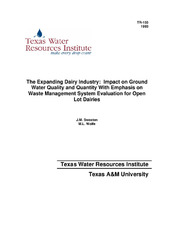| dc.description.abstract | Major expansion of the dairy industry has occurred in the last 12 years in North Central Texas, especially in Erath County. For several decades, this area has been the location of small dairy farms with sufficient land to maintain low animal densities on pastures except during milking operations. Today, however, new dairy operations are typically much larger (500-1,000 or more head) and maintain milking and dry cattle in open lots or corrals on small areas relative to the number of cows, in a manner that is similar to practices in the desert Southwest. Typical animal spacings in open lots are 56 m2 (600 square feet) pa cow. Large amounts of water are used for manure removal and milk sanitation, resulting in significant volumes of process-generated wastewater.
Concern has increased regarding the potential for ground and surface water quality degradation due to the increasing number and size of open lot dairies, particularly in the Upper North Bosque River watershed (Erath and Hamilton Counties, Texas). The outcropping of the Paluxy Formation within the watershed, which acts as a recharge zone for the Trinity Aquifer group, has led to concern about the quality of ground water in the watershed.
The Upper North Bosque River (stream segment 1226) flows through the center of Erath County and eventually enters a municipal water supply reservoir before entering the Brazos River at Waco. This stream segment has been characterized as the state's major "known problem" for agricultural nonpoint source water quality pursuant to 1988 and 1990 assessments under Section 319 of the Federal Clean Water Act (TWC, 1988). Animal confinement operations, specifically dairy operations, were identified as primary contributors to the problem.
A number of interagency research and demonstration projects have been initiated since 1988 in response to the concerns about water quality degradation due to open lot dairies. A common goal of these projects is to obtain and disseminate data and information related to the design and evaluation of dairy waste management practices. The results of these studies will aid producers, engineers, planners, and regulatory officials in the refinement and adoption of appropriate practices for water quality protection. | en |


